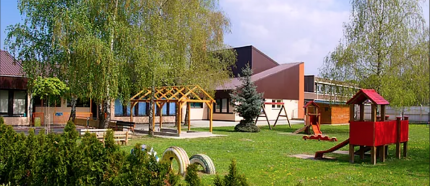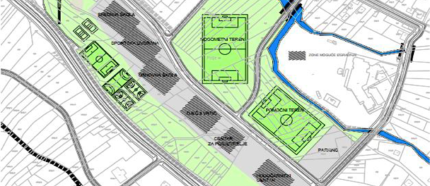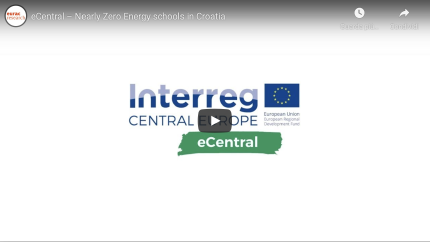PILOT ACTION 1 - CROATIA
Renovation and enlargement of 'Slavuj' kindergarten building in Sveta Nedelja

'Slavuj' kindergarten building
- 1. GENERAL DESCRIPTION
Positive demographic changes in the City of Sveta Nedelja are putting constant pressure on providers of pre- school educational services. The basic economic and financial analysis showed that the construction of a new public kindergarten would be a more reasonable solution than providing further subsidies for children who wish to attend public kindergartens rather than private ones. A better control of pre-school education standards and improvement of overall image as a social sensitive city present additional argument for this solution.
Potential technological solutions for heating and cooling of the new nZEB kindergarten building proved to be the biggest dilemma. Therefore, life-cycle costs were studied over a 10, 20 and 30 years in order to properly reflect financial effects of each technological solution. A version which foresees a heat pump system (water-water) combined with a PV system proved to be the most cost-optimal solution. Results of the economic analysis did not show significant differences compared to the financial analysis.
- 2. ENERGY RENOVATION STRATEGIES
New buildings are increasingly constructed to demanding energy performance levels, and the path has already been laid within Energy Performance of Buildings Directive (EPBD) for all new buildings to have nearly zero energy requirements.
Energy Efficiency Directive (EED) complements other requirements within EU legislation concerning the renovation of buildings and requires EU countries to establish long-term strategies for mobilising investment in the renovation of national buildings stock. Croatia has drawn up Long-Term Strategy for Mobilising Investment in the Renovation of the National Building Stock of the Republic of Croatia to show how it is planned to foster investment in the renovation of residential and commercial buildings.
- 3. FINANCIAL MODEL
A preliminary PPP analysis proved the applicability of Design-Build-Maintain PPP model. However due to the small size of the investment a traditional financing model was more cost-effective for the City. Therefore, the City will invest its own funding for construction of the kindergarten while further PPP testing will be performed for construction of nZEB schools in municipalities of Marija Bistrica and Stupnik.
Construction of new primary and music school with a sports hall in Marija Bistrica

Planned location for the school construction
- 1. GENERAL DESCRIPTION
Due to the constant growth of municipal population and devastating damage caused by the recent earthquake on municipal buildings, the local government of Marija Bistrica is faced with public demands for higher quality of public services. Existing primary and music school are becoming too small, technically obsolete and are lacking a hall to provide sport and recreation activities for students.
To address this growing demand for public school and educational services the municipality planned to construct a new, modern nZEB building in accordance with national educational standards. This way, the municipality would be able to provide public educational services for up to 600 students.
- 2. ENERGY RENOVATION STRATEGIES
Although the nZEB standard for educational buildings is set at 55 kWh/m2 and 30% of renewable energy production, the municipality decided to go beyond that and required the building to be designed to produce 100% of energy from local renewable energy sources. Continental Croatia does not have one predominant source of renewable energy so different combinations come into consideration (solar, biomass, geothermal).
PPP screening report initially estimated total costs for construction of primary and music school with a sports hall and outdoor sport facilities at approximately EUR 11 million (without VAT).
- 3. FINANCIAL MODEL
The goal of eCentral’s pilot action was to perform an assessment of whether a public-private partnership (PPP) model is likely to offer better value for the public than traditional public procurement (i.e. value for money analysis (VfM). Therefore, a PPP screening report and Public Sector Comparator (PSC) analysis were made to determine if and which PPP model would be the most adequate and affordable for the municipality.
PSC analysis proved that Design-Build-Finance (DBF) model would be more suitable than the traditional model for construction of the new primary and music school with a sports hall in Marija Bistrica. Next steps in the process include development of DBF model terms of reference, project contract (with financial structuring, financial model, risk allocation, service standards, payment mechanism, guarantee drafts) and preliminary design of the school.
Construction of new primary with a sports hall in Stupnik

Planned location for the school construction
- 1. GENERAL DESCRIPTION
Due to the constant growth of municipal population and non-existence of primary schools in Stupnik, the local government is faced with public demands for construction of municipality’s own school. Students from Stupnik have to attend schools in the City of Zagreb for which the municipality has an organized transportation.
To address growing demands for construction of municipal public school and educational services local government plans to construct a new, modern nZEB building in accordance with national educational standards. This way, the municipality would be able to provide public educational services for up to 360 students.
- 2. ENERGY RENOVATION STRATEGIES
Although the nZEB standard for educational buildings is set at 55 kWh/m2 and 30% of renewable energy production, the municipality decided to go beyond that and required the building to be designed to produce 100% of energy from local renewable energy sources. Continental Croatia does not have one predominant source of renewable energy so different combinations come into consideration (solar, biomass, geothermal).
PPP screening report initially estimated total costs for construction of primary school with a sports hall and outdoor sport facilities at approximately EUR 8 million (without VAT).
- 3. FINANCIAL MODEL
The goal of eCentral’s pilot action was to perform an assessment of whether a public-private partnership (PPP) model is likely to offer better value for the public than traditional public procurement (i.e. value for money analysis (VfM)). Therefore, a PPP screening report and Public Sector Comparator (PSC) analysis were made to determine if and which PPP model would be the most adequate and affordable for the municipality.
PSC analysis proved that Design-Build-Finance (DBF) model would be more suitable than the traditional model for construction of the new primary school with a sports hall in Stupnik. Next steps in the process include development of DBF model terms of reference, project contract (with financial structuring, financial model, risk allocation, service standards, payment mechanism, guarantee drafts) and preliminary design of the school.

